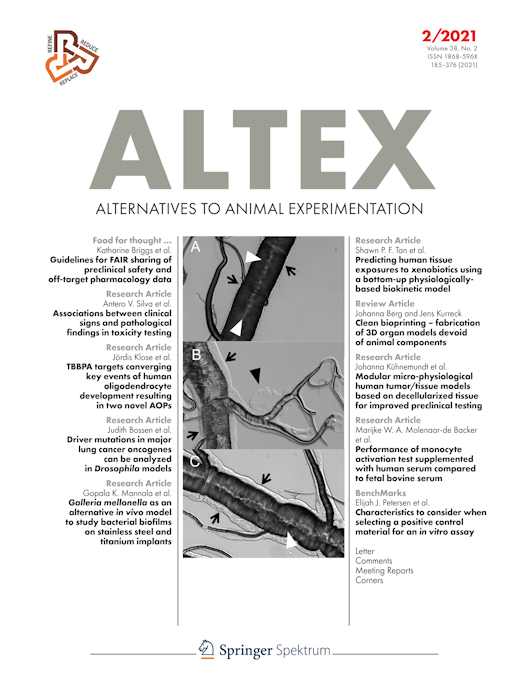Application of computational methods in replacement – an IPAM webinar
Main Article Content
Article Details

This work is licensed under a Creative Commons Attribution 4.0 International License.
Articles are distributed under the terms of the Creative Commons Attribution 4.0 International license (http://creativecommons.org/licenses/by/4.0/), which permits unrestricted use, distribution and reproduction in any medium, provided the original work is appropriately cited (CC-BY). Copyright on any article in ALTEX is retained by the author(s).
Alberga, D., Trisciuzzi, D., Montaruli, M. et al. (2019). A new approach for drug target and bioactivity prediction: The multi-fingerprint similarity search aLgorithm (MuSSeL). J Chem Inf Model 59, 586-596. doi:10.1021/acs.jcim.8b00698
Alberga, D., Gambacorta, N., Trisciuzzi, D. et al. (2020). De novo drug design of targeted chemical libraries based on artificial intelligence and pair based multiobjective optimization. J Chem Inf Model 60, 4582-4593. doi:10.1021/acs.jcim.0c00517
Cavaliere, F., Montanari, E., Emerson, A. et al. (2017). In silico pharmacogenetic approach: The natalizumab case study. Toxicol Appl Pharmacol 330, 93-99. doi:10.1016/j.taap.2017.07.011
Cavaliere, F. and Cozzini P. (2018). New in silico trends in food toxicology. Chem Res Toxicol 31, 992-993. doi:10.1021/acs.chemrestox.8b00133
Cavaliere, F., Lorenzetti, S. and Cozzini, P. (2020). Molecular modelling methods in food safety: Bisphenols as case study. Food Chem Toxicol 137, 111116. doi:10.1016/j.fct.2020.111116
De Angelis, I., Ricceri, L. and Vitale, A. (2019). The 3R principle: 60 years taken well. Ann Ist Super Sanita 55, 398-399. doi:10.4415/ANN_19_04_15
Etna, M. P., Giacomini, E., Rizzo, F. et al. (2020). Optimization of the monocyte activation test for evaluating pyrogenicity of tick-borne encephalitis virus vaccine. ALTEX 37, 532-544. doi:10.14573/altex.2002252
Gissi, A., Gadaleta, D., Floris, M. et al. (2014). An alternative QSAR-based approach for predicting the bioconcentration factor for regulatory purposes. ALTEX 31, 23-36. doi:10.14573/altex.1305221
Ives, C., Campia, I., Wang, R.-L. et al. (2017). Creating a structured AOP knowledgebase via ontology-based annotations. Appl In Vitro Toxicol 3, 298-311. doi:10.1089/aivt.2017.0017
Jeliazkova, N., Apostolova, M. D., Andreoli, C. et al. (2021). Towards FAIR nanosafety data. Nat Nanotechnol, in press.
Kochev, N., Jeliazkova, N., Paskaleva, V. et al. (2020). Your spreadsheets can be FAIR: A tool and FAIRification workflow for the eNanoMapper database. Nanomaterials (Basel) 10, E1908. doi:10.3390/nano10101908
Kolle, S. N., Landsiedel, R. and Natsch, A. (2020). Replacing the refinement for skin sensitization testing: Considerations to the implementation of adverse outcome pathway (AOP)-based defined approaches (DA) in OECD guidelines. Regul Toxicol Pharmacol 115, 104713. doi:10.1016/j.yrtph.2020.104713
Nicolotti, O. and Carotti, A. (2006). QSAR and QSPR studies of a highly structured physicochemical domain. J Chem Inf Model 46, 264-276. doi:10.1021/ci050293l
Nicolotti, O., Benfenati, E., Carotti, A. et al. (2014). REACH and in silico methods: An attractive opportunity for medicinal chemists. Drug Discov Today 19, 1757-1768. doi:10.1016/j.drudis.2014.06.027
OECD (2016). Users’ Handbook supplement to the Guidance Document for developing and assessing Adverse Outcome Pathways. OECD Series on Adverse Outcome Pathways, No. 1. OECD Publishing, Paris. doi:10.1787/5jlv1m9d1g32-en
Sakuratani, Y., Horie, M. and Leinala, E. (2018). Integrated approachess to testing and assessment: OECD activities on the development and use of adverse outcome pathways and case studies. Basic Clin Pharmacol Toxicol 123, Suppl 5, 20-28. doi:10.1111/bcpt.12955
Wilkinson, M. J., Dumontier, M., Aalbersberg, I. J. et al. (2016). The FAIR guiding principles for scientific data management and stewardship. Sci Data 3, 160018. doi:10.1038/sdata.2016.18
Wittwehr, C., Aladjov, H., Ankley, G. et al. (2017). How adverse outcome pathways can aid the development and use of computational prediction models for regulatory toxicology. Toxicol Sci 155, 326-336. doi:10.1093/toxsci/kfw207


